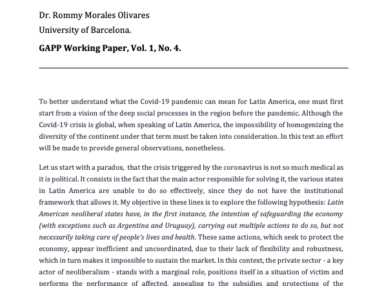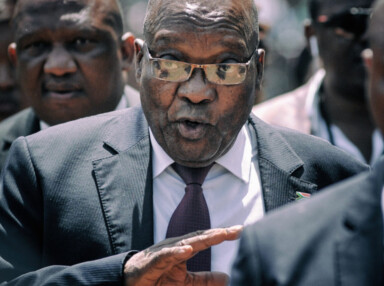Getting government right, now – and after Covid-19
South Africa, like the rest of the world, is in the midst of an emergency. The full scale and magnitude of its impact is unprecedented. No-one knows what the outcome will be and the forecasts are frightening. How should South Africa manage the current crisis? The tendency is to look at the international experience; yet our own recent history might also offer important lessons.
When democracy finally came to South Africa in 1994, the country was in long-term economic decline. In the 1990s real per capita GDP fell by 0.4% a year. Inflation had been steadily increasing since the 1970s and by 1991 was well over 15%. Many conservative economists anticipated a “Malthusian” effect after 1994 as population growth overwhelmed an economy unable to keep up. This, as we know, is not what happened. Instead, the democratic transition saw inflation decline appreciably, even dropping below zero in 2004. Today it ranges between 4% and 7%. The economy even managed to grow at above 5% between 2004 and 2007 – until the global financial crisis hit. Economic measures introduced after 1996 were heavily contested and they have been held responsible for consolidating and deepening inequality in South Africa. At the same time, social programmes in health, education, housing, water, sanitation, electricity and social grants had a reach never imagined before.
The story of the transition is not simply a tale of economic and social policies, however. It is also a story of government – how it is configured and its responsiveness. Behind the economic numbers above was a successful effort at institution-building, especially in the fiscal space. The South African Revenue Services (SARS) was created in 1997 at the same time that a formative National Treasury was established.
There was a long period when democracy in South Africa was associated with the modernisation and professionalisation of government. There were many contrary trends as well, including the inappropriate politicisation of government departments and administrations and the appointment of unsuitable persons to key positions. The municipal sphere has been an area of particular difficulty. Nonetheless, the momentum was generally positive. The hosting of the Soccer World Cup in 2010 was a high point. In the face of international and domestic scepticism about the ability of an African country to host a successful tournament, South Africa glowed in the aftermath.
What we call “State Capture” represented a major setback, especially in the sphere of government. So we enter the current crisis not simply with a fragile economy but with a weakened state. The comparison with the 1990s is compelling.
Yet the lesson from our brief post-apartheid experience is that we can avoid and/or manage our way successfully through crises when we invest in building institutions. More than ever we need to be applying that lesson in the current crisis. We know, moreover, a lot about how to do it. The challenge is to set this capability free.
Epidemiologists and doctors can track the spread of the Covid-19 virus and have thus far demonstrated a welcome capability in this regard. There has been sterling work by economists on devising an economic response to the emergency. There are numerous business and civil-society initiatives. In the end, the effectiveness of these measures, however, will depend on the integrity, professionalism and capacity of institutions, whether of government, of business or of civil society. It will also depend on their ability to coordinate and collaborate.
The governance challenge is considerable. South Africa needs to hit a moving target (the virus as it spreads) consistently. A constant flow of reliable information is needed to inform rational plans and regulations. Diverse resources must be marshalled and allocated. They must be distributed through myriad government departments, agencies, companies, organisations. Hard trade-offs, often deferred, are now unavoidable. Getting this right is not just an interesting problem. Lives depend on it. The economy depends on it.
The ruling party is deeply fragmented and cannot operate like, say, a Chinese Communist Party, speaking with a single, determined voice. The political culture is combative with a tendency towards factionalism and patronage, often leading to violence.
Currently, various models of government are being stress-tested. Each province seems to have its own model. Yet there are three that are worth noting for the moment.
The KwaZulu-Natal approach is based on a single plan operating across the province to provide comprehensive, integrated and transversal services to communities through effective and efficient partnerships. This approach has proven to have lasting power, and successive premiers from Sbu Ndebele to Sihle Zikalala have stayed the course of Operation Sukuma Sakhe (OSS), as it is called. Is it being considered as a blueprint in the current crisis?
In Gauteng, Premier David Makhura outlined a very detailed planning model in his State of the Province Address (SOPA). At the heart of the Gauteng plan is a framework for “model-based planning” that uses statistical data and modelling techniques to interpret demographic and economic trends and plan services and infrastructure in relation to these dynamics. As some commentators have noted, this is an important departure from the way planning usually happens in South Africa. Government departments aren’t able to digest such information – “their ears cannot receive,” as Pali Lehohla puts it.
The Western Cape model is closer to the Gauteng model than the KwaZulu-Natal one, and it is stronger, particularly in relation to the deployment of monitoring and evaluation tools as well as compliance. The provincial government of the Western Cape has received high marks from the Auditor-General as the best performing institution of government. Yet the performance of Western Cape municipalities beyond the City of Cape Town has been variable.
Any planning model must be rooted in the context in which it is to be located. It must frame the key questions intended for resolution. In this regard, it has also to be realistic. In the South African context, such a model would have to pay attention to questions of institutional capacity but also to questions about South African society. The ruling party is deeply fragmented and cannot operate like, say, a Chinese Communist Party, speaking with a single, determined voice. The political culture is combative with a tendency towards factionalism and patronage, often leading to violence.
Under these conditions, what would an effective development planning system look like that is responsive to evidence, and to democratic pressure, can make good decisions quickly, and that can coordinate many different actors in a common national effort? We have solved this conundrum before. We must do it again now.
Our past experience suggests the following guidelines and guiding questions:
- Government is fixed yet the virus (like an economy) is mobile. What is the right spatial unit for planning? Is it the province, the region, the metro, the district?
- Buy-in from diverse partners sometimes requires formal structures, sometimes it requires “soft power” and leadership.
- Compliance cannot simply be coerced. It needs to be incentivised. This may include “nudging” individual behaviour change and the development of social norms.
- Given that government essentially operates by outsourcing, what are the best options for supply-chain management?
- How does the government encourage partnerships and innovation through engagement with the private sector and with civil society?



